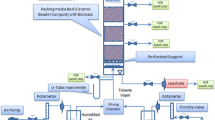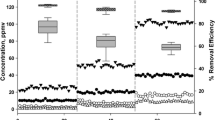Abstract
Trichloroethylene (TCE) is an environmental contaminant provoking genetic mutation and damages to liver and central nerve system even at low concentrations. A practical scheme is reported using toluene as a primary substrate to revitalize the biofilter column for an extended period of TCE degradation. The rate of trichloroethylene (TCE) degradation byPseudomonas putida F1 at 25°C decreased exponentially with time, without toluene feeding to a biofilter column (11 cm I.D.×95 cm height). The rate of decrease was 2.5 times faster at a TCE concentration of 970 μg/L compared to a TCE concentration of 110 μg/L. The TCE itself was not toxic to the cells, but the metabolic intermediates of the TCE degradation were apparently responsible for the decrease in the TCE degradation rate. A short-term (2 h) supply of toluene (2,200 μg/L) at an empty bed residence time (EBRT) of 6.4 min recovered the relative column activity by 43% when the TCE removal efficiency at the time of toluene feeding was 58%. The recovery of the TCE removal efficiency increased at higher incoming toluene concentrations and longer toluene supply durations according to the Monod type of kinetic expression. A longer duration (1.4∼2.4 times) of toluene supply increased the recovery of the TCE removal efficieny by 20% for the same toluene load.
Similar content being viewed by others
References
Oldenhuis, R., J. Y. Odedzes, J. J. Waarde, and D. B. Janssen (1991) Kinetics of chlorinated hydrocarbon degradation byMethylosinus trichlorosporium OB3b and toxicity of trichloroethylene.Appl. Environ. Microbiol. 57: 7–14.
Cox, C. D., H. J. Woo, and K. G. Robinson (1998) Cometabolic biodegradation of trichloroethylene (TCE) in the gas phase.Water Sci. Technol. 37: 97–104.
Nakamura, Y., M. Daidai, and F. Kobayashi (2004) Bioremediation of phenolic compounds having endocrinedisrupting activity using ozone oxidation and activated sludge treatment.Biotechnol. Bioprocess Eng. 9: 151–155.
Kim, J.-H., W.-H. Jeong, T. B. Karegoudar, and C.-K. Kim (2002) Stable degradation of benzoate byKlebsiella oxytoca C302 immobilized in alginate and polyurethane.Biotechnol. Bioprocess Eng. 7: 347–351.
Kleopfer, R. D., D. M. Easley, B. B. Hass, Jr. T. G. Deihl, D. E. Jackson, and F. P. Guengerich (1985) Anaerobic degradation of trichloroethylene in soil.Environ. Sci. Technol. 19: 277–280.
Vogel, T. M. and P. McCarty (1986) Biotransformation of tetrachloroethylene to trichloroethylene, dichloroethylene, vinyl chloride, and carbon dioxide under methanogenic conditions.Appl. Environ. Microbiol. 49: 1080–1083.
Speital, G. E. Jr. and D. S. McLay (1993) Biofilm reactors for treatment of gas stream containing chlorinated solvents.J. Environ. Eng.-ASCE. 119: 658–678.
Dolasa, A. R. and S. J. Ergas (1999) Membrane bioreactor for cometabolism of trichloroethene air emissions.J. Environ. Eng.-ASCE. 126: 969–973.
Arciero, D., T. Vannelli, M. Logan, and A. B. Hooper (1989) Degradation of trichloroethylene by the ammoniaoxidizing bacteriumNitrosomonas europaea.Biochem. Bioph. Res. Co. 159: 640–643.
Hyman, M. R., S. A. Russell, R. L. Ely, K. J. Williamson, and D. J. Arp (1995) Inhibition, inactivation, and recovery of ammonia-oxidizing activity in cometabolism of trichloroethylene byNitrosomonas europaea.Appl. Environ. Microbiol. 61: 1480–1487.
Chang, H. L. and L. Alvarez-Cohen (1997) Two stage methanotrophic bioreactor for the treatment of chlorinated organic wastewater.Water Res. 31: 2026–2036.
Pressman, J. G., G. Georgiou, and G. E. Speital (1999) Demonstration of efficient trichloroethylene biodegradation in a hollow fiber membrane bioreactor.Biotechnol. Bioeng. 62: 681–692.
Sukesan, S. and M. E. Watwood (1997) Continuous vapor-phase trichloroethylene biofiltration using hydrocarbon-enriched compost as filtration matrix.Appl. Microbiol. Biotechnol. 48: 671–676.
Lackey, L. W., J. R. Gamble, and J. L. Boles (2002) Bench-scale evaluation of a biofiltration system used to mitigate trichloroethylene contaminated air streams.Adv. in Environ. Res. 7: 97–104.
Ely, R. L., K. J. Williamson, R. B. Guenther, M. R. Hyman, and D. J. Arp (1995) A cometabolic kinetics model incorporation enzyme inhibition, inactivation, and recovery: I. Model development, analysis, and testing.Biotechnol. Bioeng. 46: 218–231.
Ely, R. L., M. R. Hyman, D. J. Arp, R. B. Guenther, and K. J. Williamson (1995) A cometabolic kinetics model incorporation enzyme inhibition, inactivation, and recovery: II. Trichloroethylene degradation experiments.Biotechnol. Bioeng. 46: 232–245.
Zhang, X. H. and R. K. Bajpai (2000) A comprehensive model for the cometabolism of chlorinated solvents.J. Environ. Sci. Health. A35: 229–244.
Stainer, R. Y., N. J. Palleroni, and M. Doudoroff (1966) The aerobicPseoudomonas: a taxonomic study.J. Gen. Appl. Microbiol. 43: 159–171.
Lenore, S. C., E. G. Arnold, and D. E. Andrew (1998)Standard Methods for the Examination of Water and Wastewater. 18th ed., American Public Health Association Press, Washington DC, USA.
Li, S. and L. P. Wackett (1992) Trichloroethylene oxidation by toluene dioxygenase.Biochem. Bioph. Res. Co. 185: 443–451.
Wackett, L. P. and D. Gibson (1988) Degradation of trichloroethylene by toluene dioxygenase in whole cell studies withPseudomonas putida F1.Appl. Environ. Microbiol. 54: 1703–1708.
Wackett, L. P. and S. R. Householder (1989) Toxicity of trichloroethylene toPseudomonas putida F1 is mediated by toluene dioxygenase.Appl. Environ. Microbiol. 55: 2725–2725.
Author information
Authors and Affiliations
Corresponding author
Rights and permissions
About this article
Cite this article
Jung, IG., Park, OH., Woo, HJ. et al. Recovery of trichloroethylene removal efficiency through short-term toluene feeding in a biofilter enriched withPseudomonas putida F1. Biotechnol. Bioprocess Eng. 10, 34–39 (2005). https://doi.org/10.1007/BF02931180
Received:
Accepted:
Issue Date:
DOI: https://doi.org/10.1007/BF02931180




